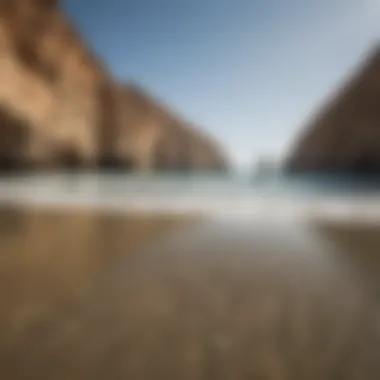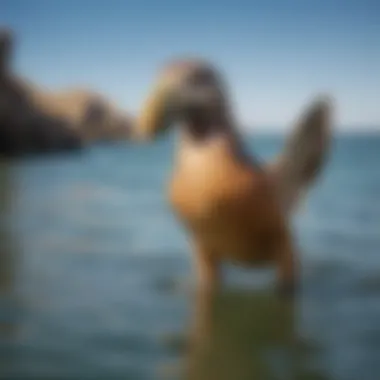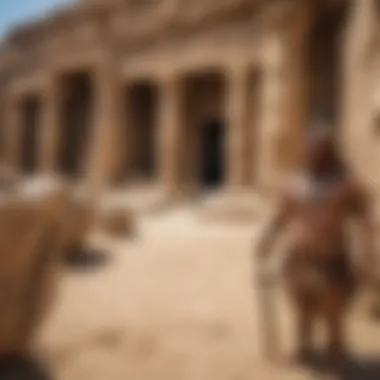Exploring the Paracas: A Comprehensive Guide


Intro
Paracas, a name that resonates with rich cultural history and stunning natural beauty, invites explorers and researchers alike to delve into its wonders. Nestled along the southern coast of Peru, this region is famous not only for its archaeological treasures but also for its breathtaking landscapes and ecosystems. The Paracas National Reserve, with its vibrant marine life and unique desert terrain, stands as a testament to the ecological diversity that this area boasts.
Yet, Paracas is more than just a feast for the eyes. It is a hotbed of ancient civilizations, where the Paracas culture thrived long before the Inca Empire emerged. The remnants of their majestic tapestries and burial sites scatter across the land, offering glimpses into a past that continues to captivate curious minds.
For those eager to uncover the secrets of Paracas, this guide aims to provide essential insights. The focus will span across historical contexts, archaeological landmarks, and the ecological significance of the region, illustrating its relevance not only to travelers but also to researchers committed to conservation efforts.
A crucial part of understanding any region lies in exploring its narrative—both human and natural. Here, we aim to paint a comprehensive picture of what makes Paracas a vital chapter in the story of our planet's heritage. This guide presents a blend of rich history, culture, and the pressing need for sustainability, catering to those who seek knowledge and adventure in a land where every grain of sand tells a tale.
Intro to Paracas
The Paracas region in Peru stands as a remarkable destination not only for its striking landscapes but also for its deep cultural and historical significance. Understanding the introduction to Paracas sets the stage for appreciating its multifaceted value—spanning ecological richness and archaeological wonders.
When we think of Paracas, it becomes clear that it’s more than just a pretty vacation spot tucked away on the southern coast of Peru. This area invites researchers and thrill-seekers alike to explore its treasures.
In today's context, highlighting the unique elements of Paracas provides a gateway to recognizing its global importance, especially how it factors into environmental conversations and cultural heritage preservation. Travelers can find immense benefits in delving into what Paracas has to offer, including its stunning beaches perfect for kiteboarding, diverse wildlife, and ancient history. The region’s natural grandeur complements its historical significance, creating a well-rounded narrative that can capture anyone’s imagination.
Geographical Overview
Paracas is situated about 260 kilometers south of Lima, boasting a coastal landscape that is both rugged and beautiful. The Paracas National Reserve covers a significant part of this region, where the Pacific Ocean meets dramatic cliffs and desert terrain. This area is often characterized by its arid climate with minimal rainfall, making it an intriguing study in ecosystems.
The mesmerizing beaches treat visitors to breathtaking sunrises and sunsets, perfect for photography and leisure. One cannot overlook the stunning desert landscapes either, which provide ideal conditions for various water sports, particularly kiteboarding. The wind here is favorable, making it a prime spot for enthusiasts, instructors, and event organizers alike.
Significance in History
Paracas is steeped in history that goes back thousands of years, primarily linked to the Paracas civilization. Established as early as 800 BC, this culture is notable for its advancements in textile technology and burial practices. The historical significance lies not only in their daily life but also in the symbolism they impart, evident through their intricate burial sites. The Paracas Necropolis, for example, serves as a testament to their cultural practices that involved elaborate mummification, hinting at a belief system deeply rooted in spirituality.
Additionally, the region has played host to various archaeological studies that continue to shed light on how ancient civilizations interacted with the environment. Through research endeavors, attention is brought to the technological innovations employed in farming and textile production—a true reflection of human adaptation and resilience.
An impressive aspect is the geoglyphs, some of which hold deep meanings perhaps lost to time. These large figures carved into the earth remind us of how past civilizations left their marks on the land, enduring symbols to link us with our heritage. Collectively, these historical elements enrich our understanding of the region’s role in the larger context of Andean cultures, revealing Paracas as a crucial stepping stone in the evolution of civilization.
"Understanding the geographical and historical significance of Paracas enhances our appreciation, fostering a connection that transcends mere visitations and evolves into profound reverence for this ancient land."
Whether you’re an avid traveler, a kiteboarding aficionado, or a history buff, getting acquainted with Paracas’s unique position in both ecology and history offers an enriching experience that is both informative and transformative.
Cultural Heritage of Paracas
The cultural heritage of Paracas is a cornerstone for understanding the region's historical and modern significance. This aspect doesn’t just represent a collection of old artifacts; it embodies the very essence of how the Paracas people lived, thrived, and influenced their surroundings. The intricacies of their culture can teach us not only about their daily activities but also their relationship with nature and spirituality. For visitors, this heritage adds rich layers to their experiences, making a trip to Paracas not just a leisurely escape but a dive into the depths of history.
The Paracas Civilization
Origins and Development
The Paracas civilization traces its roots back to around 800 BC. They developed along the southern coast of Peru, where the harsh desert and the adjacent ocean created a unique environment for both survival and innovation. One key characteristic of their origins is the delicate balance they struck between agriculture and fishing. The Paracas people ingeniously adapted to their surroundings, relying heavily on the rich marine resources while cultivating crops in the limited arable land available.
Understanding this aspect is beneficial for those looking to grasp how ancient societies learned to coexist with their environment. The sophisticated irrigation systems they developed highlight a unique feature of nursery gardens, often found along the riverbanks, which expanded their agricultural output. However, this dependence on natural resources also posed disadvantages, particularly when climate fluctuations or resource depletion occurred, illustrating both resilience and vulnerability in their way of life.
Key Achievements
Key achievements of the Paracas civilization primarily include their exceptional textile production and fascinating burial practices. Mastery of weaving techniques allowed them to create vibrant textiles not only for practical use but also for ceremonial purposes. What stands out about these textiles is their intricate patterns and bold colors, often reflecting the cultural significance of nature and their beliefs. This characteristic makes the textiles a vital element of their cultural identity.
Another unique feature is the discovery of expansive necropolis, which serves as a window into their funerary customs. The elaborate burial mounds, filled with goods, provide insight into their social structure, religious beliefs, and artistry. These achievements remain a rich source of study for archeologists and historians, further enhancing the Paracas's importance in the broader narrative of Andean cultures.
Influence on Andean Cultures
The influence of the Paracas civilization rippled through subsequent Andean cultures, particularly within the realms of art, architecture, and social organization. They set a precedent in textile arts that transcended their civilization, inspiring later communities such as the Nazcas. The bold style and techniques of Paracas textiles have been reflective in countless artifacts found across the Andes.
Moreover, their burial practices paved the way for future civilizations to develop their own customs concerning death and the afterlife. Paracas served as a crucial point of transition in cultural evolution in the Andes, where traditions and innovations intermingled. The synthesis of local customs and external influences ultimately shaped the cultural landscape we see today in Peru.


Archaeological Sites
The Paracas region boasts a remarkable array of archaeological sites, revealing crucial insights into its past. Unraveling the legacies of ancient civilizations, these sites not only enrich our understanding of history but also highlight the cultural significance of the Paracas landscape. When exploring these remnants, one can appreciate the intricate connections between the past and present. Here, we delve into two key archaeological highlights: The Paracas Necropolis and the Geoglyphs.
The Paracas Necropolis
The Paracas Necropolis is a fascinating burial site located near the coastline. Discovered in the early 20th century by archaeologist Julio Tello, this site contains elaborate tombs that once housed the remains of the Paracas people, who lived here from approximately 800 BCE to 100 BCE. It is not solely the quantity of the tombs that captivates; rather, it’s the artistry evident in each one that lays bare a sophisticated culture.
In these tombs, archaeologists found numerous artifacts, including textiles, ceramics, and tools. The most striking aspect of the necropolis is the exceptional preservation of textiles, crafted with skill that echoes through the ages. The colors and complex designs are a testament to the advanced weaving techniques of the Paracas artisans. These materials not only serve as a glimpse into their daily life but also indicate a society rich in traditions and beliefs about the afterlife.
"The Paracas Necropolis stands as a monument to a society that valued art, culture, and an understanding of life beyond death."
Visiting the necropolis offers a poignant experience. Strolling among the tombs, one can almost feel the whispers of those who walked before us, infused with the spirits of their ancestors. This sacred site reminds us of the importance of preservation and care for our cultural heritage.
Geoglyphs and Their Meanings
The geoglyphs of Paracas are another significant archaeological feature, blending art with the natural landscape. These massive figures, etched into the desert floor, stretch for hundreds of meters and are visible from great distances. They date back to around 200 BCE and continue to remain a topic of intrigue.
Among the most famous geoglyphs is the figure known as the "Candelabro," a large representation shaped like a candelabra. The purpose and meaning of these figures are still debated among scholars. Some suggest they functioned as navigation markers for ancient mariners, while others propose religious or ritualistic significance.
The sheer scale and precision of these geoglyphs demonstrate an incredible understanding of geometry and astronomy. It raises one’s eyebrows to think how ancient civilizations managed to create such large-scale artworks without modern technology. Hiking through the Paracas desert to view these mystical shapes offers a unique perspective, allowing visitors to reflect on the ingenuity of humanity across time.
Natural Environment of Paracas
The natural environment of Paracas is not just a backdrop; it plays a pivotal role in the region's cultural and ecological richness. Its unique geography and climate foster diverse ecosystems that are vital for both local wildlife and visitors seeking outdoor adventures. Understanding this environment enhances appreciation for its beauty and significance, making it an essential part of any discussion about Paracas.
Topography and Climate
The topography of Paracas is a fascinating mix of rugged cliffs, sandy beaches, and expansive desert. It features a breathtaking coastline along the Pacific Ocean, which creates a striking contrast with the arid landscapes typical of the interior. The area is characterized by wind-sculpted formations, some looking as if they belong in a painter's gallery rather than on Earth.
Paracas enjoys a mild desert climate, marked by warm temperatures and a consistent breeze off the ocean. This climate means that the region generally offers pleasant conditions for outdoor activities throughout the year. The coastal fog, known as "garúa," nourishes the arid lands, providing essential moisture that supports life in this otherwise dry region. The balance of humidity from the ocean and the arid heat of the desert make the environment unique and dynamic.
Biodiversity in Paracas
Flora
The flora of Paracas is remarkably adapted to its environment, exhibiting resilience and a unique beauty. Among its notable species, the coastal plant known as allowed, with its glossy leaves and vibrant flowers, thrives despite the challenging conditions. This plant not only offers visual delight but serves as crucial habitat for various insects and birds. The tough, drought-resistant plants found here are excellent at stabilizing the soil, preventing erosion that could otherwise devastate this fragile ecosystem.
A key characteristic of Paracas's flora is its ability to survive with limited water. Some plants exhibit thick, succulent leaves, storing moisture for dry periods. This adaptability showcases nature's ingenuity. However, these plants face risks from climate change and human activities that threaten their habitats, spotlighting the need for conservation.
Fauna
The fauna of Paracas is just as captivating. The region boasts several endemic bird species, like the Peruvian pelican, which take to the skies, riding the coastal winds. The local marine life, notably the adorable sea lions and vibrant dolphins, add to the allure, making the waters off Paracas a prime spot for wildlife enthusiasts and photographers.
A key feature of the fauna is the migration patterns of birds, which are drawn to the rich feeding grounds offered by the nutrient-rich waters. This diversity provides invaluable insights into the intricate relationships within the ecosystem. However, pressures from fishing and tourism can affect these wildlife populations, leading to concerns about sustainability.
"Understanding the flora and fauna of Paracas is integral to appreciating its natural beauty and cultural significance. Conserving these ecosystems not only protects biodiversity but also safeguards the heritage of the region."
In short, the natural environment of Paracas serves as a lens through which to view broader concepts of ecology, sustainability, and heritage. Both the flora and fauna represent the delicate balance of life in this region, making it more than just an aesthetically pleasing landscape. For kiteboarders and outdoor enthusiasts, recognizing the richness of this environment can transform a visit into a deeply enriching experience.
Paracas National Reserve
The Paracas National Reserve represents a crucial intersection of natural beauty and ecological significance. This protected area, established in 1975, is not just a glimpse into the stunning coastal landscapes of Peru but a beacon of conservation in the region. Home to diverse ecosystems, it serves as a habitat for numerous species of flora and fauna, some of which are endemic. However, its importance goes beyond mere visuals; it plays a vital role in maintaining ecological balance and protecting endangered coastal wildlife.
Establishment and Purpose
The formation of Paracas National Reserve was driven by the recognition of both its environmental and historical importance. The reserve encompasses over 335,000 hectares, a mix of marine and terrestrial habitats that are rich in biodiversity. Its primary purpose is to protect critical habitats, particularly for migratory birds and marine species. The waters are teeming with life, including various fish species, sea lions, and even the occasional whale.
Founded in the hope of safeguarding these precious resources, the reserve aims to promote sustainable tourism practices that do not compromise the integrity of the environment. It works to balance conservation efforts with the needs of local communities, demonstrating that ecological preservation and economic viability can coexist harmoniously.
"The Paracas National Reserve is a prime example of how conservation can be both beautiful and beneficial."


Conservation Efforts
Conservation here embodies various methodologies aimed at preserving the rich biodiversity of the reserve. One primary approach is through active monitoring programs that track species populations and health. These initiatives ensure that changes in the environment are noted and addressed promptly.
Local organizations also play a foundational role in educating the public about sustainable practices and the significance of biodiversity. Community-led efforts to reduce plastic use and fishing restrictions help to lessen human impact on the area.
Moreover, collaborative initiatives with international bodies have opened up channels for funding and resources. This cooperation fosters a united front against poaching and habitat destruction, while also pushing for research that furthers our understanding of these unique ecosystems.
The commitment to maintaining the ecological health of the Paracas National Reserve reflects an understanding that the region’s future relies on its inhabitants, both human and wildlife alike. Engaging local communities in these conservation efforts is not merely beneficial; it's essential for ensuring that the natural beauty and biodiversity of Paracas endure for generations to come.
Tourism in Paracas
Tourism in Paracas is not just a mere activity; it serves as a vital lifeline for the region’s economy and culture. The lush landscape intertwines seamlessly with the arid coastline, creating a striking backdrop for tourists. As travelers flock to this unique destination, they contribute to the local economy while celebrating the rich tapestry of natural and cultural heritage that defines Paracas.
Attractions and Activities
Water Sports
Water sports in Paracas are a thrilling way to engage with the vibrant marine environment. From kiteboarding to kayaking, the options are abundant for adventure seekers. Kiteboarding, in particular, attracts enthusiasts from around the globe. The consistent winds and favorable weather conditions create an ideal setting for both beginners and seasoned riders. This sport not only provides adrenaline-pumping experiences but also deepens one’s appreciation for the natural beauty of the Paracas National Reserve.
A key characteristic of water sports here is the diversity they offer. You might find yourself gliding over crystal-clear waters one moment, then exploring hidden coves the next. This flexibility makes water sports a popular choice among tourists of varying levels of ability. However, it’s important to note that while the exhilaration is robust, safety gear and knowledge of local conditions are crucial.
Wildlife Viewing
Wildlife viewing in Paracas presents an invaluable opportunity to witness the region's rich biodiversity. The area is teeming with life, from playful sea lions to a variety of seabirds. The Ballestas Islands are a hotspot for this, often referred to as the “Galapagos of Peru” due to the sheer volume of wildlife. Birdwatching here is particularly rewarding; species such as the Peruvian Booby and the Humboldt Penguin can be spotted.
The unique feature of wildlife viewing in Paracas lies in its accessibility. Tour operators often provide boat tours that take you close to the animals in their natural habitat without disturbing them. This offers an enriching educational experience, allowing visitors to learn about conservation efforts while enjoying breathtaking landscapes. On the flip side, the popularity of these tours can lead to overcrowding at certain spots, so it is wise to choose your excursion times accordingly.
Travel Tips
Best Times to Visit
Understanding the best times to visit Paracas is essential for maximizing your experience. The region enjoys a semi-arid climate, which means it’s pleasant almost year-round. However, the dry months from June to September are particularly favored, as they boast sunny days and moderate temperatures. If you’re into water sports, this is prime time as winds are more reliable, making it perfect for kiteboarding.
Visiting during these peak months generally means more activities and tours are available. Just keep in mind that this popularity can lead to increased crowds. Planning ahead can help you secure accommodations and book tours in advance, providing a smoother experience.
Accommodation Options
When it comes to accommodation options in Paracas, the variety is quite striking. From luxury resorts that overlook the ocean to budget-friendly hostels, there's something for every traveler. Establishments like La Hacienda Bahia Paracas offer upscale amenities along with stunning views; it’s quite common to wake up to the sound of waves crashing nearby.
On the other hand, if you’re looking for a more communal experience, there are hostels that provide clean, cozy spaces to meet fellow adventurers. The unique feature of staying in a local establishment is that it often allows for greater interaction with the community, enhancing the overall experience. The downside can be the unpredictability of service in smaller lodges. In that case, researching reviews can be quite helpful.
"Experience in Paracas will leave impressions that linger much longer than your stay. The interplay between wild beauty and rich culture is something that shouldn’t be missed."
Prioritize what matters most to you—be it luxury, adventure, or ambiance. With thoughtful planning, your visit to Paracas promises to be as rewarding as it is unforgettable.
Economic Impact of Tourism
Tourism plays a pivotal role in shaping the economy of Paracas, a region known for its abundant cultural and natural attractions. This impact is multifaceted, influencing local businesses, employment opportunities, and infrastructural development. By examining the economic threads woven by tourism, we can gain insight into its significance in the broader context of Paracas's growth and sustainability.
Local Economy
In Paracas, tourism serves as a catalyst for local economic advancement. Small businesses, from artisan shops to family-run restaurants, thrive on the influx of tourists seeking authentic experiences. Visitors often look to purchase handcrafted goods, which not only helps preserve local traditions but also provides artisans with a sustainable source of income. As kiteboarding becomes increasingly popular in the region, gear rentals and schools have emerged, catering to both newbies and seasoned pros alike. This evolution has encouraged the growth of specialized services and enhanced competition among providers, fostering innovation and improving quality.
Jobs created in the tourism sector often extend beyond direct service roles; they ripple into various domains such as transportation, hospitality, and local agriculture. For instance, local farmers may find their organic produce becoming highly sought after in restaurants catering to health-conscious travelers.
Despite its promise, the local economy is also susceptible to external factors such as seasonal fluctuations. During peak seasons, businesses often flourish, while off-season may leave some workers struggling. Therefore, a balanced view of tourism's role in Paracas's economy must recognize these cyclical challenges, ensuring that economic growth does not compromise resource sustainability.
"The symbiosis between tourism and the local economy can bolster not just financial independence but also cultural richness and biodiversity of the Paracas region."


Challenges and Opportunities
The economic landscape of Paracas presents various challenges alongside opportunities. While tourism generates capital, it can also strain local resources and infrastructure. Increased foot traffic brings wear and tear to natural sites, which calls for proactive measures to mitigate impact.
One significant concern is the management of waste generated by tourism activities. Local governments and organizations face the task of creating sustainable waste management practices to protect the delicate ecosystems.
On the flip side, there are emerging opportunities that could reshape the economic fabric of Paracas. By promoting eco-tourism, stakeholders can attract travelers who prioritize environmental stewardship. This shift not only benefits nature but also encourages sustainable business models for local operators. Educational programs and events focusing on conservation can raise awareness and foster community participation, creating jobs while protecting the region's allure.
Furthermore, leveraging digital marketing platforms can enhance visibility for Paracas as an attractive destination, drawing in kiteboarders and nature enthusiasts alike. Engaging with social media channels could effectively target audiences who are ready to explore and invest in experiences that leave a lasting impact.
In summary, the economic impact of tourism in Paracas is significant, presenting both challenges and numerous opportunities. Understanding the nuances of this relationship will be crucial for guiding the region toward a sustainable and prosperous future.
Environmental Challenges
Understanding the environmental challenges facing Paracas is crucial, not just for the well-being of the region itself but for the global community as a whole. Situated along the southern coast of Peru, this unique area serves as a habitat for various species. The ecological balance is delicate, and disruptions can have lasting impacts. The following sections explore the specific environmental threats and climate change effects that Paracas grapples with.
Threats to Biodiversity
The biodiversity in Paracas is nothing short of remarkable. From diverse marine life to unique terrestrial plants, the region is home to ecosystems that are begging for protection. However, threats loom large. Overfishing is one of the primary tasks that many species need to face, as local communities often rely heavily on these resources for their livelihoods. Unsustainable fishing practices can lead to a drastic decline in fish populations, disrupting the food chain.
The introduction of invasive species also tosses a spanner in the works. These non-native plants and animals often outcompete local species, leading to a loss of indigenous biodiversity. Local conservation efforts are akin to putting a Band-Aid on a leaking dam if broader action isn't taken.
"The Paracas region serves as a reminder that ecosystems are interconnected; the loss of one species can ripple through the entire biosphere."
Finally, pollution is another significant threat. Several industries operate near the reserve, and waste runoff threatens to contaminate the water and soil, thus harming the delicate ecosystems.
Impact of Climate Change
The effects of climate change come barreling down as a major challenge. For places like Paracas, rising sea levels may seem like a distant threat, but they pose genuine concerns for both the environment and the community. Coastal erosion becomes a reality, endangering habitats and human settlements alike. The unusual temperature fluctuations can upset established natural cycles, affecting breeding grounds for marine and avian life.
Furthermore, altered weather patterns result in unpredicted disruptions in rainfall and water availability. This could spell disaster for both local agriculture and water quality. Shifts in ocean temperature can lead to phenomena such as coral bleaching, impacting the underwater ecosystems critical to marine life.
In summary, addressing these environmental challenges is not merely an academic exercise but a practical necessity to ensure the preservation of Paracas's treasured biodiversity and its ecosystems. One way or another, our actions today will write the story of tomorrow, emphasizing the importance of a collective approach in conserving this unique part of our planet.
Future of Paracas
As we peep into the crystal ball of Paracas, it's imperative to grasp the delicate balance between preserving its unique heritage and tailoring it for sustainable growth. The concerns regarding environmental protection, cultural preservation, and economic development intertwine in this captivating locale. The future of Paracas hinges on sustainable development practices and the fostering of community engagement, which collectively safeguard this area's richness while allowing locals and visitors to thrive alike.
Sustainable Development Practices
Future sustainability in Paracas calls for a well-thought-out approach that prioritizes both ecological integrity and community welfare. Key practices might include:
- Responsible Tourism Practices: Educating visitors on local customs can reduce the cultural footprint tourism may leave. This involves promoting eco-friendly activities like kiteboarding in designated areas that minimize disruption to wildlife and sensitive ecosystems.
- Utilization of Renewable Resources: The sun-drenched landscapes of Paracas are perfect for harnessing solar energy. Implementing solar panels in local businesses can reduce carbon footprints and overall energy costs.
- Habitat Restoration Projects: Given the area’s robust biodiversity, active efforts to restore marine and land habitats can bolster ecological resilience. Collaborating with local conservation groups to plant native species and clean up beach areas is essential.
"Sustainable development in Paracas is about shaping the future without sacrificing our past."
Community Engagement
Engaging the community in the conservation effort is paramount for success. Strong bonds between local people and conservation initiatives can lead to innovative ideas and actions to protect Paracas while benefitting its residents. Here are a few considerations:
- Educational Programs: Implementing educational initiatives in schools can inspire the next generation about the importance of environmental stewardship and cultural heritage. Classes could include everything from local history to workshops on sustainable practices.
- Collaborative Decision-Making: When developing tourism infrastructure, including the insights of local stakeholders brings fresh perspectives. These collaborations often yield projects that not only attract visitors but also align with community needs, ensuring that everyone benefits.
- Cultural Events and Workshops: Hosting regular cultural events can celebrate and promote local traditions, reinforcing pride in heritage. These activities give visitors authentic experiences while establishing a sense of ownership and responsibility among locals.
By deliberately crafting policies and practices centered on sustainability and community involvement, Paracas can maintain its allure and significance, ensuring that both its unique culture and pristine environment remain vibrant for generations to come.
Closure
Reflecting on the significance of Paracas illuminates several critical threads that weave through not only its ancient civilizations but also its modern relevance. The Paracas region stands as a testament to the resilience of its cultural heritage and the pressing need for sustainable practices. This culmination of knowledge serves as a reminder of the delicate balance between preservation and development in today’s world. For kiteboarders, instructors, enthusiasts, and event organizers, understanding the history and ecological importance of Paracas enhances the experience of engaging with this stunning coastline.
Reflecting on Paracas's Significance
The rich tapestry of Paracas's history introduces a deeper understanding of its landscapes and communities. The region is not merely a backdrop for recreational activities; it is a living museum that reflects thousands of years of human ingenuity and adaptability. Here are some key elements that underscore the significance of Paracas:
- Cultural Heritage: The archaeological sites and practices from the Paracas civilization reveal the intricate relationship these ancient peoples had with their environment. Pondering over these history-laden sites invites reflection on the lessons they offer modern society regarding sustainability.
- Biodiversity Hotspot: Paracas's unique topography and climate contribute to an incredibly diverse range of flora and fauna. The ecological richness not only attracts tourists, but also necessitates a conservation strategy to support sustainable tourism.
- Economic Potential: With the increasing interest in eco-tourism and adventure activities, Paracas presents a wealth of opportunities for the local economy. However, balance is key; entrepreneurship should align with practices that safeguard the region’s natural and historical resources.
- Community Engagement: Involving local communities in conservation and tourism initiatives fosters a sense of ownership and empowerment. This engagement can catalyze successful efforts to ensure that the beauty and history of Paracas are preserved for future generations.
"The future of Paracas lies in a collaborative approach where heritage and nature are seen as invaluable assets rather than mere commodities."
Understanding these facets indeed illustrates that the value of Paracas transcends recreational appeal. It serves as a microcosm of ongoing dialogues about cultural preservation, environmental stewardship, and sustainable development. Thus, any exploration of the Paracas area is inherently an exploration of our shared responsibility to honor and protect our planet's rich cultural and natural heritage.















